By…
The World of Work Keeps Changing – This Career Expert Suggests Leveraging Your Untapped Potential
Karen Jackson-Cox, Executive Director of the Career Advancement Centre at Smith School of Business, shares insights on the changing work landscape.

By Sarah Kelsey
Karen Jackson-Cox has spent her entire career helping people reach their full potential.
“My career has spanned the private sector to not-for-profit and education, and my focus has always been on human potential — how people can achieve more and make meaningful impact,” says the Executive Director of the Career Advancement Centre at Smith School of Business, Queen’s University. “My goal has always been to give people the tools they need to grow.”
Her first bit of advice for anyone looking to evolve or future-proof their career is to start by understanding their unique value proposition.
“Everyone should build a Personal Advisory Team — a PAT — to help build their confidence, provide diverse perspectives and honest feedback, and inspire them to grow their impact individually and as part of a team,” she says of the concept she and her team at Smith introduce to students.
It’s one way the school delivers what it calls the SmithEdge, a set of personal capabilities for the changing business environment. Students are taught how to recognize patterns of behaviour and cultural differences, understand their own behaviour tendencies to build self-awareness and resilience, and through project work, are encouraged to experience and challenge their own assumptions about the world. The goal is to help students develop interpersonal skills that will support their career evolution.
Karen advises an individual’s PAT be a diverse mix of individuals, from coaches to mentors and industry experts to friends. “It’s critical to spend time really getting to know yourself and envision what your future could look like,” Karen explains. “It’s the starting place of any good plan.” Beyond a PAT, Karen says individuals can even leverage technology like ChatGPT to suggest potential career paths based on the competencies and skills they enter into the platform. “It’s not 100 per cent accurate, but it’s a unique place to get suggestions about next steps.”
Once a person has assessed their options, Karen says the next step is working with their PAT to validate these career options and identify gaps in their resume. “You may be growing in your current area or pivoting; you should think about what the future of work looks like in either scenario,” she says.
Once opportunities for growth are identified, it’s time to upskill through education. Karen notes that nearly 50 per cent of Smith’s students successfully switch careers with their learnings from a professional master’s programs or MBA program.
Learning should be lifelong, Karen says, especially as work becomes increasingly digitized.
“Having the right mix of meta, soft, and technical skills will be even more critical,” she notes. “AI doesn’t have emotions. So, certain transferrable skills like critical and creative thinking, emotional intelligence and leadership are going to be extremely valuable in the future.” She also advises building understanding and capabilities in data analysis, coding, and social influence which will be in high demand in the future.
Karen emphasizes the significance of not only formulating a Plan A, but also a Plan B and Plan C. “Always remember skills can be applicable in multiple industries.”
As the economy ebbs and flows, job opportunities move from one industry to another. While the technology sector currently offers limited growth opportunities, the healthcare industry is experiencing a significant boom. So, if your Plan A is to find a role at a big tech company, for example, Plan B might focus on how you can leverage your skills at a major hospital or research institute.
With your plan locked in, it’s time to focus on networking.
“I’m concerned that people are more isolated,” Karen says. “A big part of future-proofing your career is staying connected and visible. It’s about building relationships with decision-makers and influencers who have a hand in the hiring process. We need to make time for in-person connections.”
What that looks like will vary by industry. One person could make connections attending a lecture while another might build a relationship interviewing a subject matter expert. The goal remains the same: to build visibility and open career pathways.
Karen believes her own hiring at Smith was aided by a panel she sat on at an industry event with the former executive director of the Career Advancement Centre. In another example, she references a student who learned of a job opportunity during a coffee chat. The student was immediately brought to the hiring manager’s office. The interaction enabled the student to secure a job in product management.
“You have to push yourself and get out of your comfort zone,” Karen says. “Writing blogs and staying active on social media are important but showing up and making time for all things in-person — that should be a big piece of your career evolution plan.”
Lastly, Karen says it’s important people know they can overcome uncertain job markets by being proactive and exploring opportunities to help them prepare for whatever is next.
“Don’t wait,” she advises. “Take inventory of your skills. Invest in higher education and upskilling. Build your team. Learn about where you want to go and how to get there. You’re designed to be someone who can continuously make an impact. Remember, you are full of untapped potential.”
By:…
Four Empowering Strategies to Overcome Imposter Syndrome
Women…
New Survey Reveals that Almost 80 per cent of Women Face Ageism in the Workplace
By:…
Adapting Leadership: Why Traditional Models Fall Short in Today’s Dynamic Workforce
You…
You Need to Meet: Dr. Dana Sinclair, a Performance Psychologist Helping Athletes and Professionals Excel
You…

